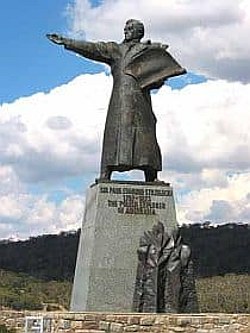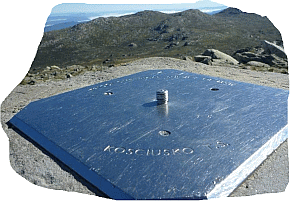Paul Strzelecki's Ascent of Mt Kosciusko part 2
By C H A S . D A L E Y , B.A. , F.L.S.
(Read before the Society, 29th April, 1941.)
Memorials on the Explorers' Routes.

In the year 1924 the centenary of Home and Hovell's expedition occurred, and a chain of memorial cairns, 38 in number, was erected along the explorers' route in Victoria from Albury to Corio Bay. In an address at the unveiling of one of these cairns at Bulla in 1925, the writer urged that the movement should be extended so as to embrace the routes of Stuart, Mitchell, McMillan, and Strzelecki.
In accordance with the suggestion, a historical Memorials' Committee, representing the Lands Department, Education Department, Historical Society of Victoria, Town-planning Association, and the Railways Department, was formed to carry out the project, Sir James Barrett being appointed chairman, and the writer, honorary secretary.
![]() Immediately, as the first portion of this extensive scheme, steps were taken to mark out the routes of McMillan and Strzelecki in Gippsland, and shire and town councils, progress associations, State schools, and the public generally along the lines of routes were invited to co-operate in the erection of memorial cairns at suitable places, carefully drawn maps of the routes with necessary particulars being distributed.
Immediately, as the first portion of this extensive scheme, steps were taken to mark out the routes of McMillan and Strzelecki in Gippsland, and shire and town councils, progress associations, State schools, and the public generally along the lines of routes were invited to co-operate in the erection of memorial cairns at suitable places, carefully drawn maps of the routes with necessary particulars being distributed.
In response, twenty-five memorials between Benambra and Port Albert on McMillan's route, and front Heyfield to Corinella on Strzelecki's were erected, entirely at local expense.
In 1927, His Excellency Lord Somers, Governor of Victoria, accompanied by the members of the Historical Committee, in a week's tour successfully performed the unveiling ceremonies along the routes.
The memorial cairns erected on the Count's route were at Heyfield, Loy Yang, Koornalla, near which he had changed his course westward, North Mirboo, Leongatha, Korumburra, and finally Corinella on Western Port, near Settlement Point.
See monuments and the plaques commemorating the expedition click &_ check here _
A link with the Polish Explorer.
In connexion with these celebrations the writer received a letter of inquiry and an appreciative message from the Polish Consul at Sydney, with the information that Mrs. Wanda Szalla, the grand-niece of the Count, was then on the Consul's staff.
The lady herself, writing in appreciation of the compliment to the Count, forwarded a copy of his will, in which, after liberal bequests, be directs his executor thus:
„ On no account should he allow a monument or tombstone or any other sign, Christian or pagan, hearing my name, to mark my resting place. For death being oblivion and time respecting nothing, a grave with a bit of turf over it, ignored by all, is the most consistent and desirable. ”
Madam Szalla in referring to the expressed wish of the Count, wrote:
„ However, I think that my growl-uncle would have had no objection if, at the summit of Mount Kosciuszko, some mark be placed stating that the mountain was named Kosciuszko by Paul Edmund Strzelecki, a Polish explorer, in commemoration of the Polish patriot, Tadeusz Kosciuszko, and that by appearance it resembles the mountain erected near Cracow by the Polish nation in honour of a great Pole. ”
The „mountain” referred to is the tumulus raised at Cracow over the grave of Kosciusko.
At Madam Szalla's wish an account of the erection of the memorial cairns in Gippsland, with photographs of the same, was forwarded to her by the writer for publication at Warsaw — to which city the lady was about to return.
A Centenary Commemoration.
In 1940, the centenary year of the ascent of Mount Kosciusko, a commemorative bronze plaque, recording the Count's eventful undertaking, was placed in position on a granite boulder at the summit of the mountain, and was unveiled on 17th February in the presence of Sir Henry Manning, representing the Government of New South Wales, and of a number of other representative persons, by the Polish Consul-General and Madame du Noskowski.
![]() Children from the Cooma and Jindabyne schools attended and sang the Polish national anthem and other suitable songs. A large party of visitors on horseback journeyed 70 miles from the Corryong district in Victoria for the occasion. The cost of the tablet was to be defrayed by subscriptions of pennies from the children in the State schools of New South Wales.
Children from the Cooma and Jindabyne schools attended and sang the Polish national anthem and other suitable songs. A large party of visitors on horseback journeyed 70 miles from the Corryong district in Victoria for the occasion. The cost of the tablet was to be defrayed by subscriptions of pennies from the children in the State schools of New South Wales.
On the tablet the date of the ascent of the mountain is given as 15th February, 1840, which is at variance with Macarthur's field-book which records that on March 12th, in the Count's company, he reached the summit.
 Our fellow-member, the Rev. Geo. Cox, who devoted much time and careful research to early Gippsland history, and was in communication with Miss Riley, granddaughter of James Riley, in referring to the episode, gives the date of the departure from Ellerslie as 2nd March, 1840,
Our fellow-member, the Rev. Geo. Cox, who devoted much time and careful research to early Gippsland history, and was in communication with Miss Riley, granddaughter of James Riley, in referring to the episode, gives the date of the departure from Ellerslie as 2nd March, 1840,